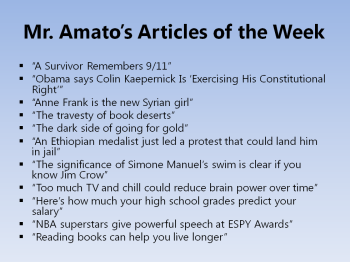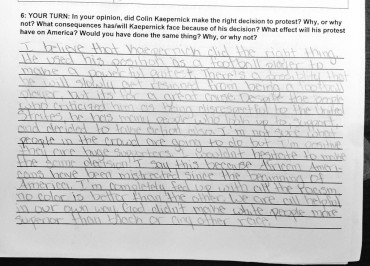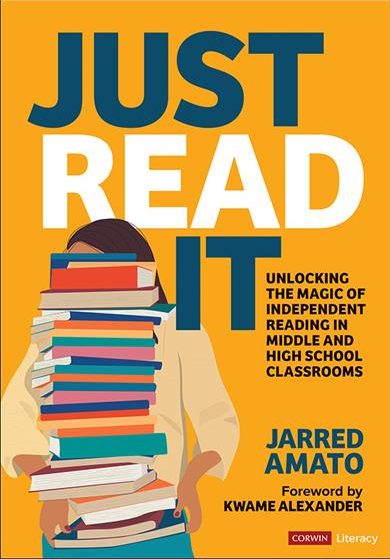It’s hard to believe that we’re already approaching the end of the first quarter of the school year in Nashville. As I reflect on the first six-and-a-half weeks, a few things stand out:
- There is tremendous value in looping. I’m teaching three sections of English I and three sections of English II, which means that I have the pleasure of working with many sophomores for a second year, and several students for a third (I previously taught eighth grade English in the same cluster).
- I’m proud to announce the launch of Project LIT (Libraries In The) Community, a student-run organization dedicated to increasing book access and eliminating book deserts in East Nashville. Follow our PBL journey by checking out the #ProjectLITCommunity hashtag on Twitter.
- The addition of the “Article of the Week” (inspired by Kelly Gallagher and Dave Stuart Jr.) to my classroom has been a game-changer. By exposing my students to relevant non-fiction articles every week, I’ve already seen tremendous growth in my students’ reading, writing, thinking, and communicating.
By assigning the AoW, my students and I have already been able to:
- Compare and contrast the Holocaust with the Syrian refugee crisis, and write persuasive letters to President Obama
- Analyze the effect of book deserts on our community, and write letters to potential partners of Project LIT Community
- Use the speech given by LeBron James and fellow NBA superstars at the ESPY Awards as inspiration for our own poems on what it’s like growing up in America today
- Understand the effects of excessive TV watching on the brain, and the importance of reading books for at least 20 minutes a day
- Examine the significance of Simone Manuel’s Olympic victory and impact of Jim Crow on African American swimmers
- Discuss the heroism of Ethiopian runner Fiyesa Lilesa, and whether we would have the courage to do the same
- Explore the post-Olympic depression that many athletes suffer from, and the importance of having multiple goals and interests
In this post, I wanted to describe the process that I use for the Article of the Week.
Step 1: Assign Article of the Week
Last week, we read “Obama Says Colin Kaepernick is ‘Exercising his Constitutional Right’” from The New York Times.
First, I had students demonstrate a close reading by annotating the text and making notes in the margins. Then, they answered the following questions:
- Complete a 5W & H graphic organizer.
- Use the graphic organizer to write a 2-3 sentence summary of the article.
- How did President Obama react to Kaepernick’s protest? Be sure to cite evidence from the text in your response.
- According to paragraph 7, what was the purpose of Kaepernick’s protest?
- Americans had very different reactions to Kaepernick’s protest. Summarize each person’s response (Megan Rapinoe, Jeremy Lane, Santa Clara police officers, etc.) in the graphic organizer below.
- YOUR TURN: In your opinion, did Colin Kaepernick make the right decision to protest? Why, or why not? What consequences has/will Kaepernick face because of his decision? What effect will his protest have on America? Would you have done the same thing? Why, or why not?
Step 2: Provide specific feedback on the AoW assignment
For each AoW assignment, I focus on specific questions to review and offer feedback. In this case, I paid close attention to the students’ summaries (question #2) since it’s a skill we have been practicing all year, as well as their reflections (question #6). I wanted to let students know that I valued and appreciated their thoughts on the topic, so that they would feel confident and comfortable sharing in our upcoming class discussion.
Step 3: Show & discuss short video to provide more background on topic
Students wrote down at least five important facts or comments they heard during this video. We then shared out & engaged in a brief discussion.
Step 4: Respect and understand both sides of the issue.
Before stating on our own thoughts on the topic, we made a T-chart of valid reasons to agree and disagree with Colin Kaepernick. We also looked at YouTube and Instagram comments as examples of what unproductive and hateful discourse looks like.
Step 5: Write one powerful sentence that states your opinion on the topic.
Before sharing our opinions aloud, each student wrote one strong claim (essentially a thesis statement) about Colin Kaepernick. I circulated the room, providing individual feedback/affirmation for each student upon completion.
Step 6: Students share their responses aloud with the class.
For this discussion, I simply asked each student to read what he or she had written. I loved this approach because it a) allowed everyone’s voice to be heard and valued, b) ensured that no person(s) could dominate the discussion, c) eliminated any fear of being attacked for having a different opinion, and d) kept the conversation focused.
As students read their statements, I had students fill out a chart with their classmates’ names and a summary of their response, which helped them be attentive listeners.
Step 7: Reflect on the discussion
The final step is perhaps the most important. After everyone had shared, we revisited our initial statements and reflected on the following questions:
- What did you learn from your classmates during the discussion?
- What did you hear that was interesting?
- Did your opinion change at all? Why, or why not?
Here’s what some students had to say:
“After the discussion, I am kind of on the fence. I don’t really know which side I stand. There were a lot of good points, and it definitely changed my view.”
“Everybody was positive and expressed their opinion. It was interesting to hear what people said. I didn’t change my opinion because I like where I stand on the issue and I feel where he’s coming from.”
“I got a better understanding of the other side of Kaepernick’ s protest. I noticed people were against him due to the disrespect towards veterans, which is fair. However, my opinion didn’t change because I still believe that we need to bring attention to the problems in America.”
“My opinion did not change, but I did get to listen to other opinions from my peers. I liked how CLASSMATE said that Kaepernick is brave for putting his career in jeopardy.”
“I liked both sides of the discussion. Some opinions made me get into a neutral position because I agree with both sides. I think everyone proved their points well. I think CLASSMATE’S claim was interesting because she stated the fact that it would get Kaepernick’s career in trouble.”
As I tweeted the other day, our responsibility as educators is not to force all students to agree. Rather, it is to teach them to defend their beliefs while respecting those with different ones. Through this AoW process, I am able to do that.
